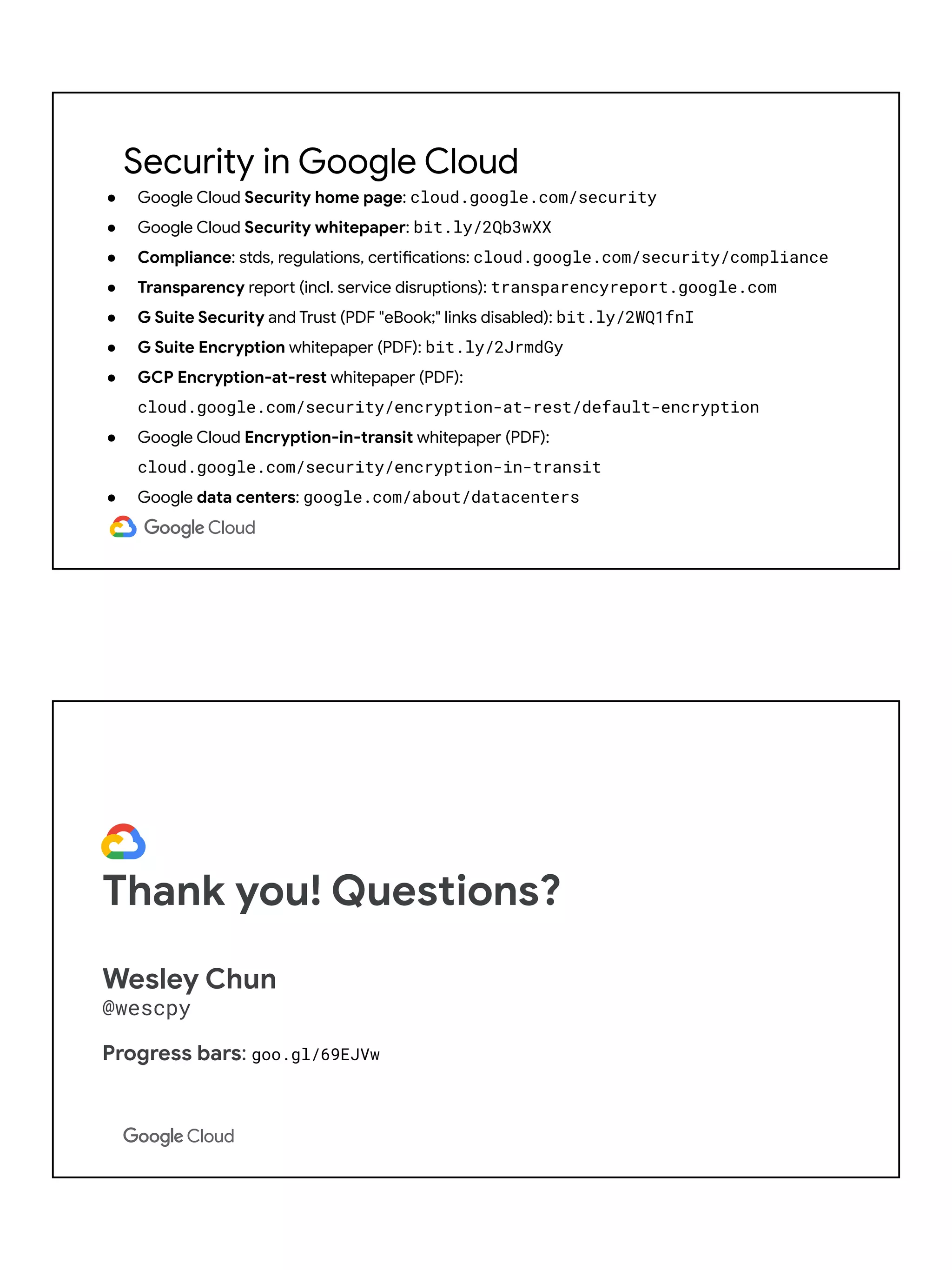The document provides an overview of cloud computing and an introduction to Google Cloud. It discusses the different types of cloud services including Software as a Service (SaaS), Platform as a Service (PaaS), and Infrastructure as a Service (IaaS). It then introduces various Google Cloud Platform (GCP) and G Suite products and services that fall under each category. Examples of code snippets using GCP and G Suite APIs in Python are also provided to demonstrate interacting with these cloud services programmatically.
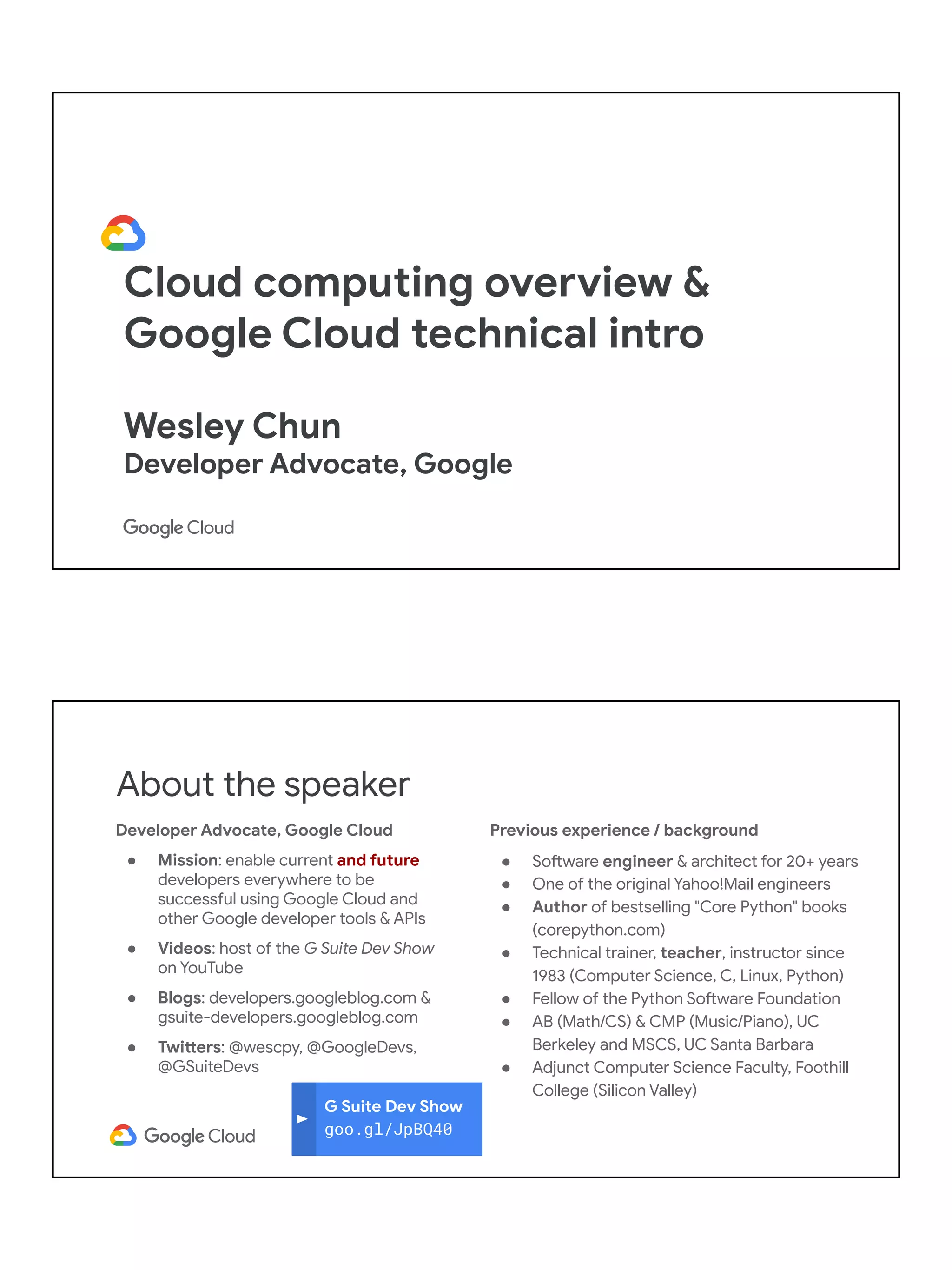

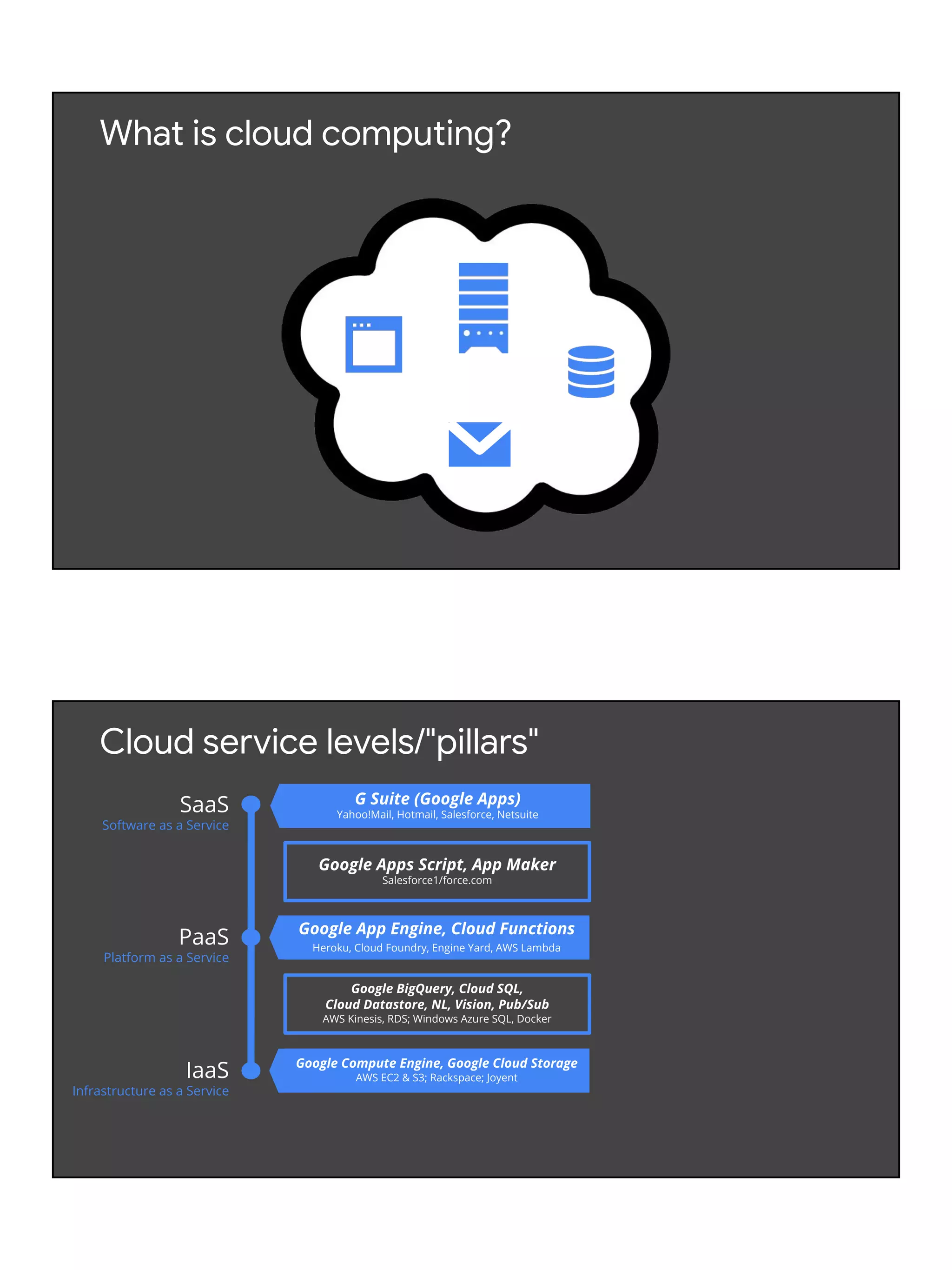

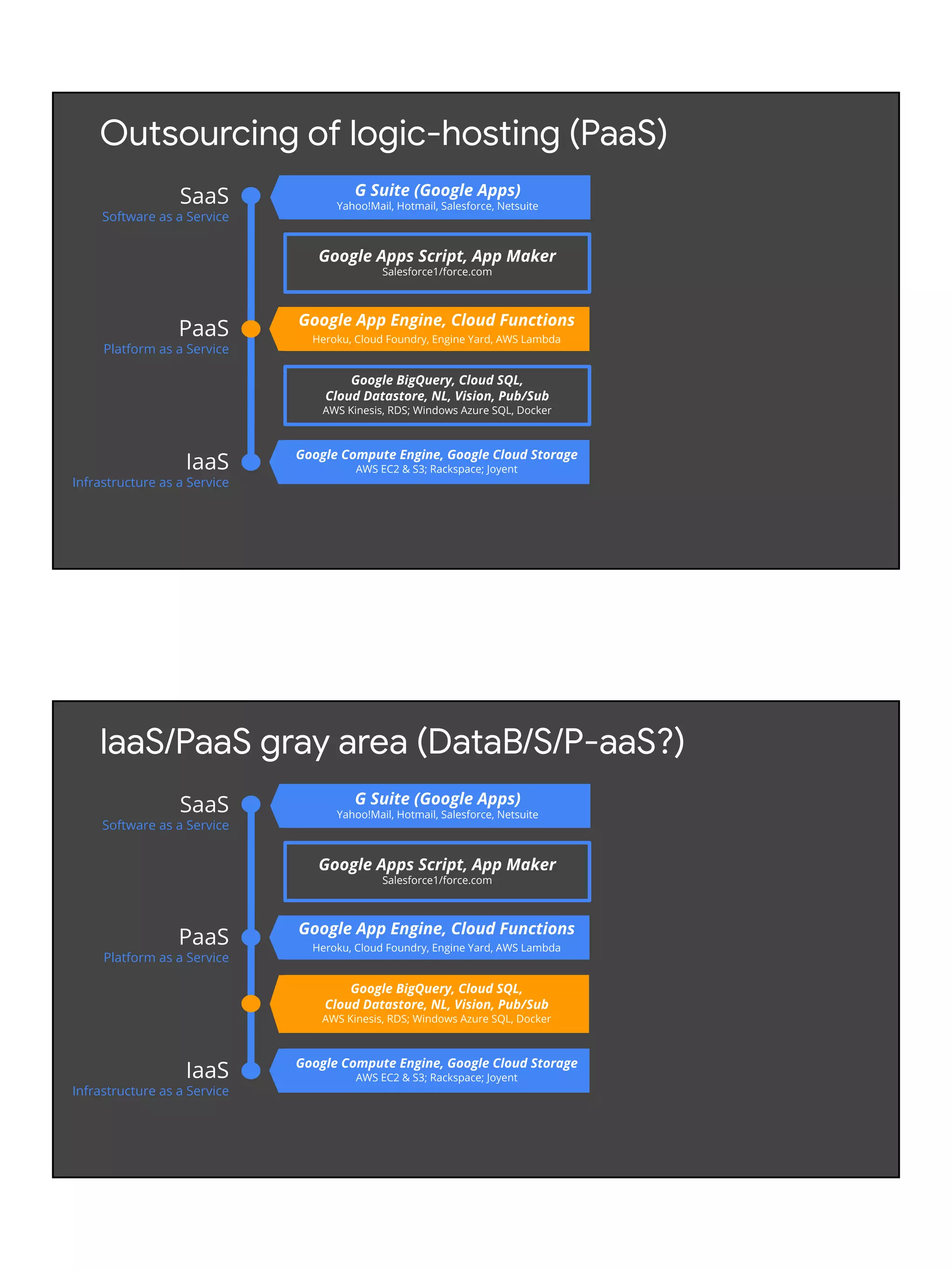


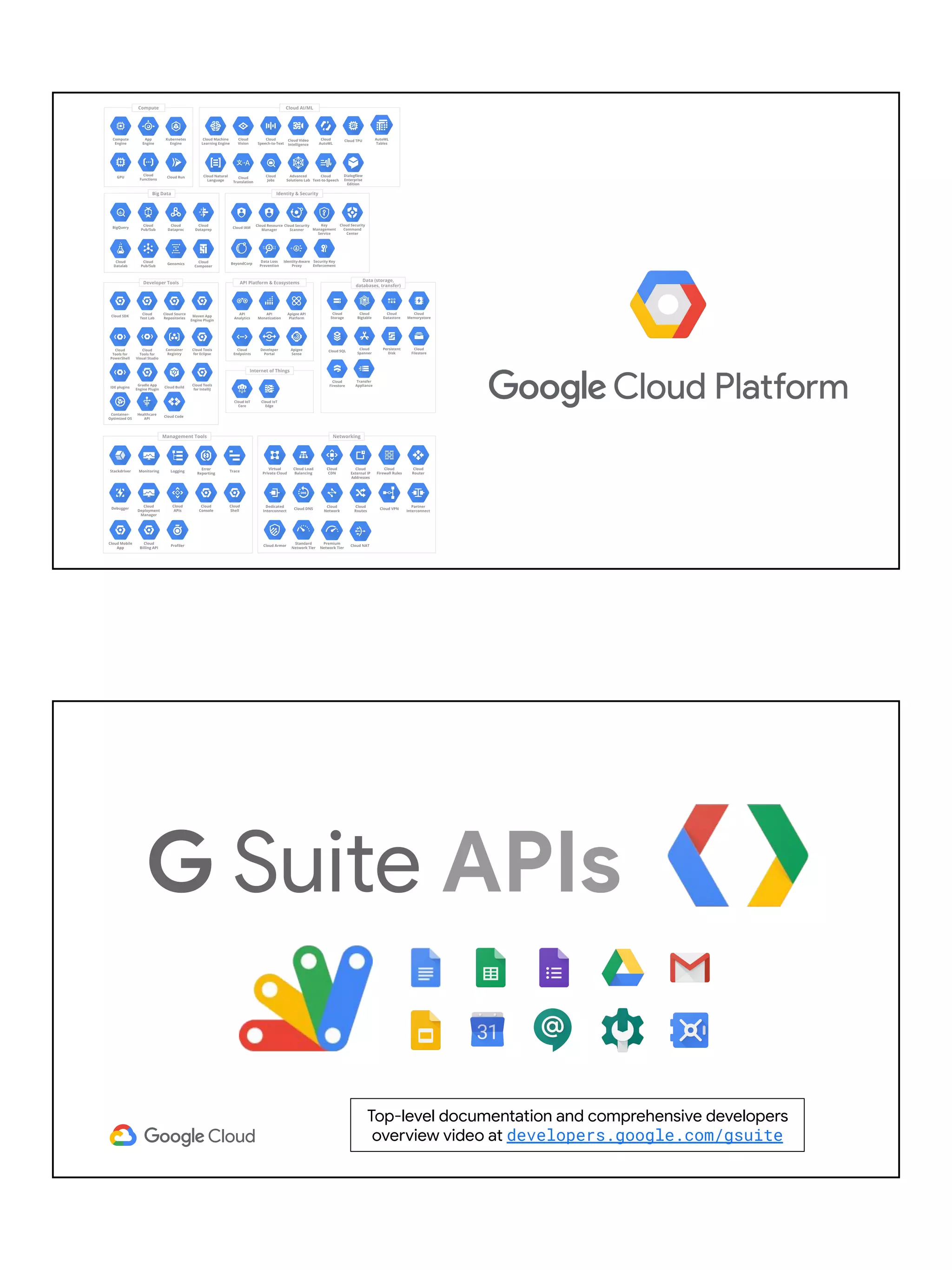
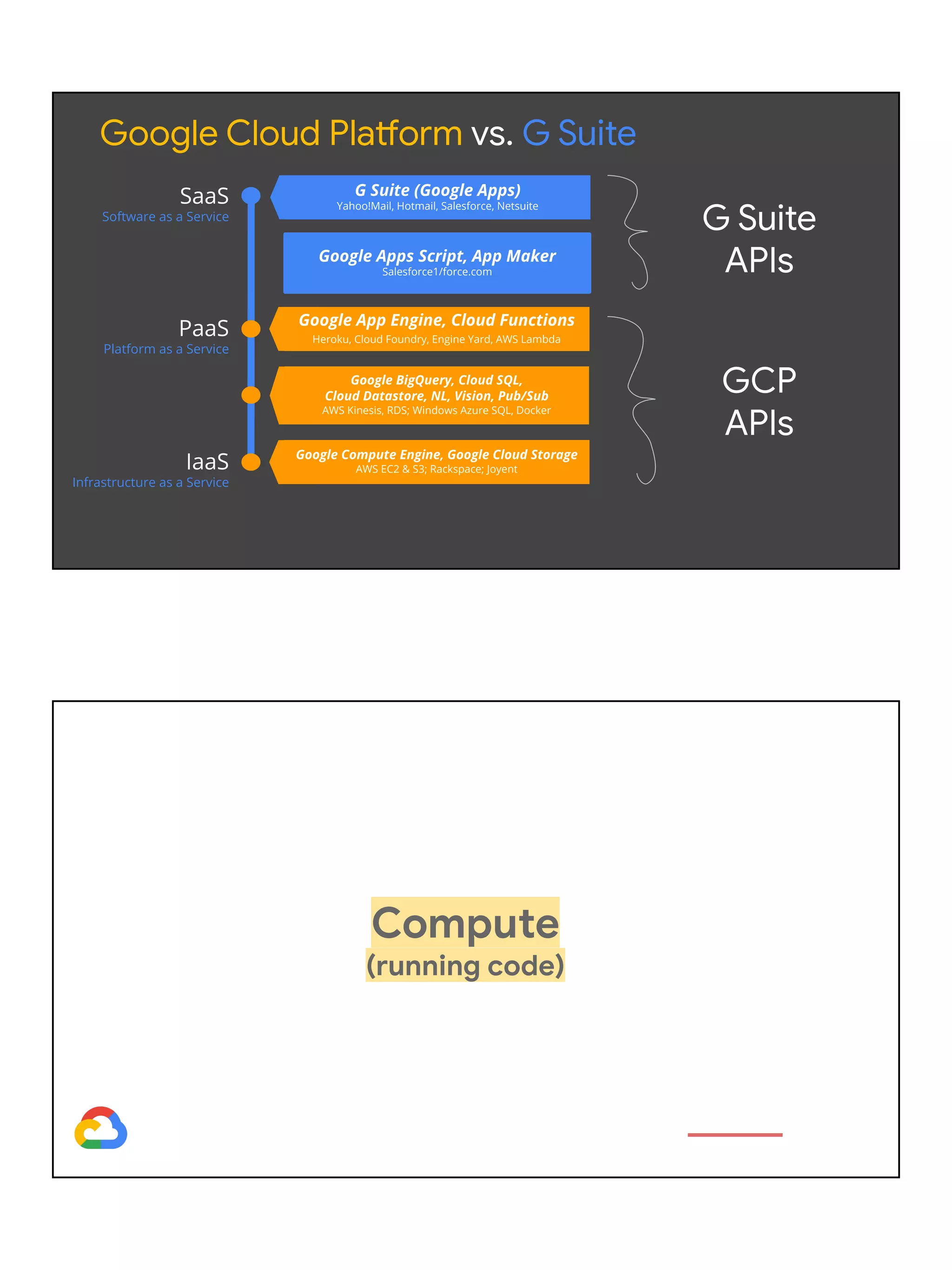

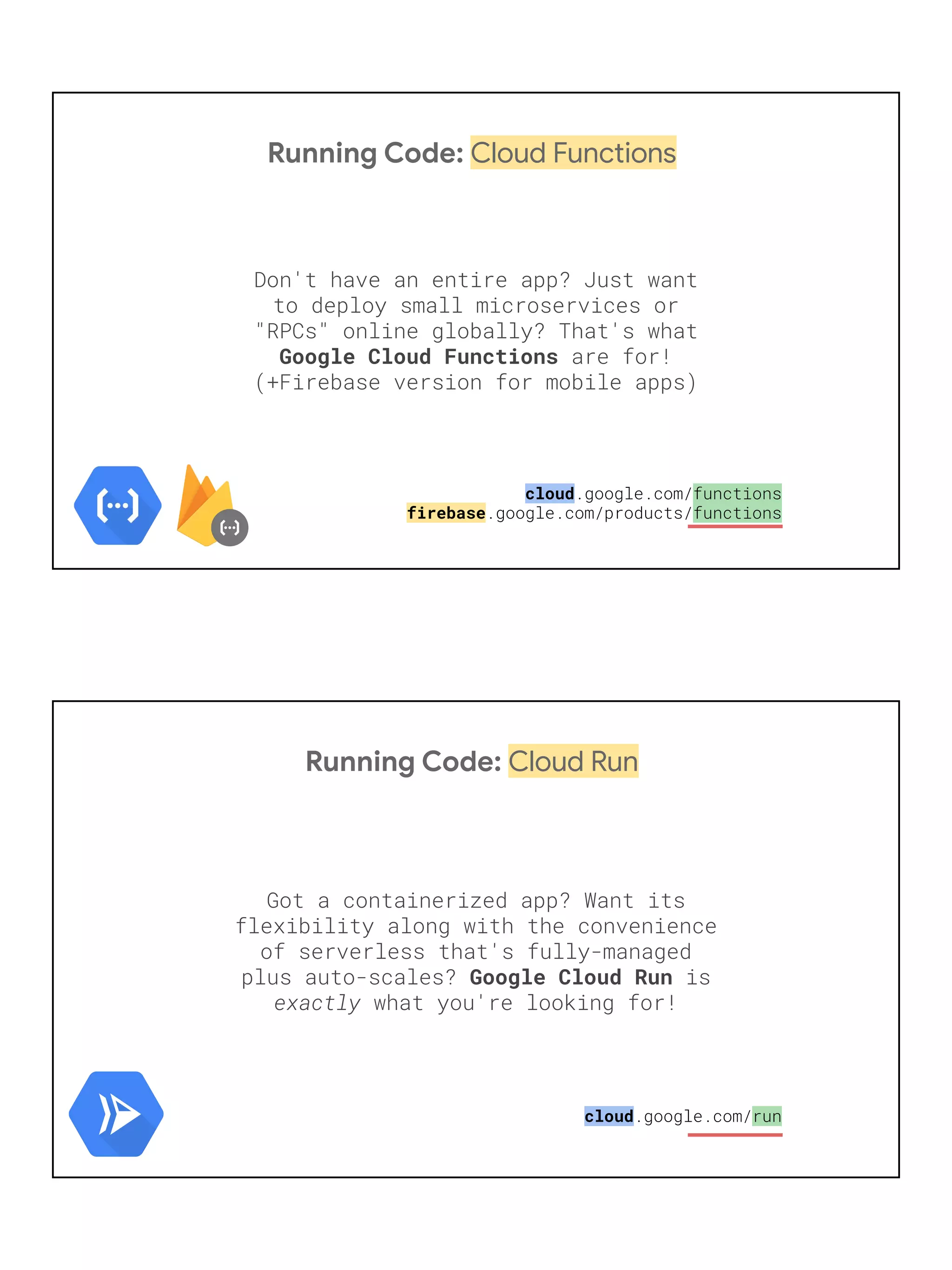
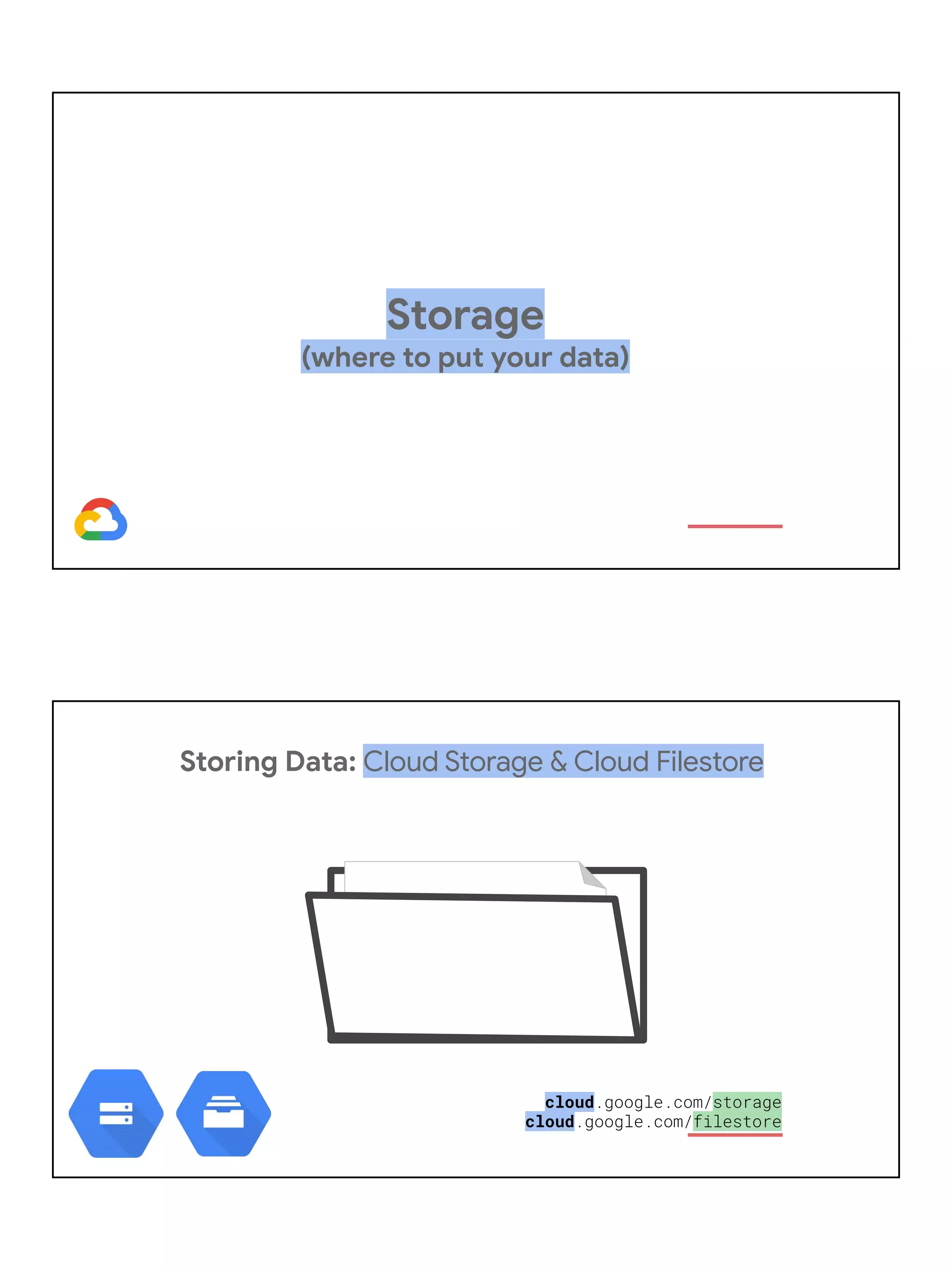

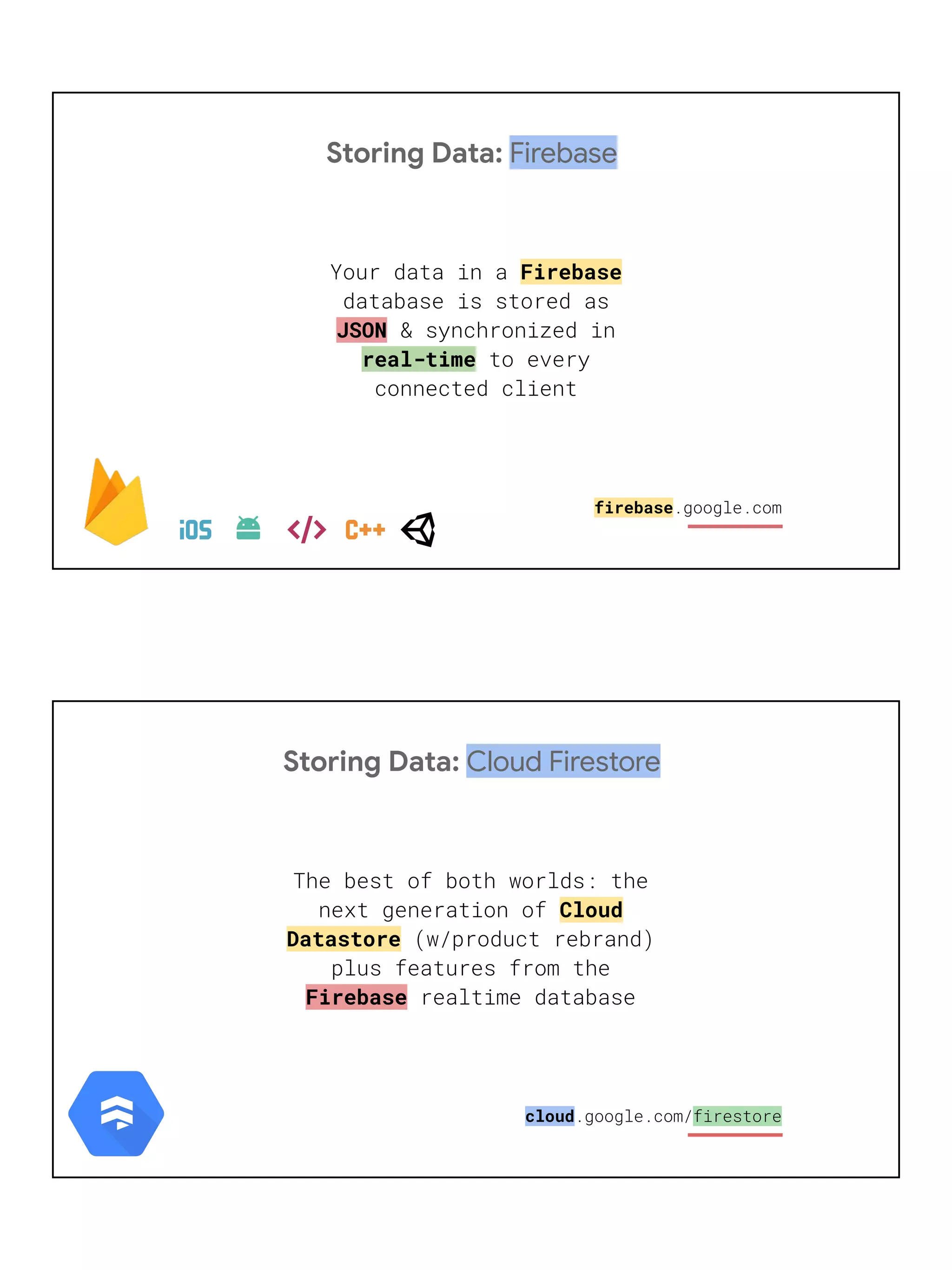

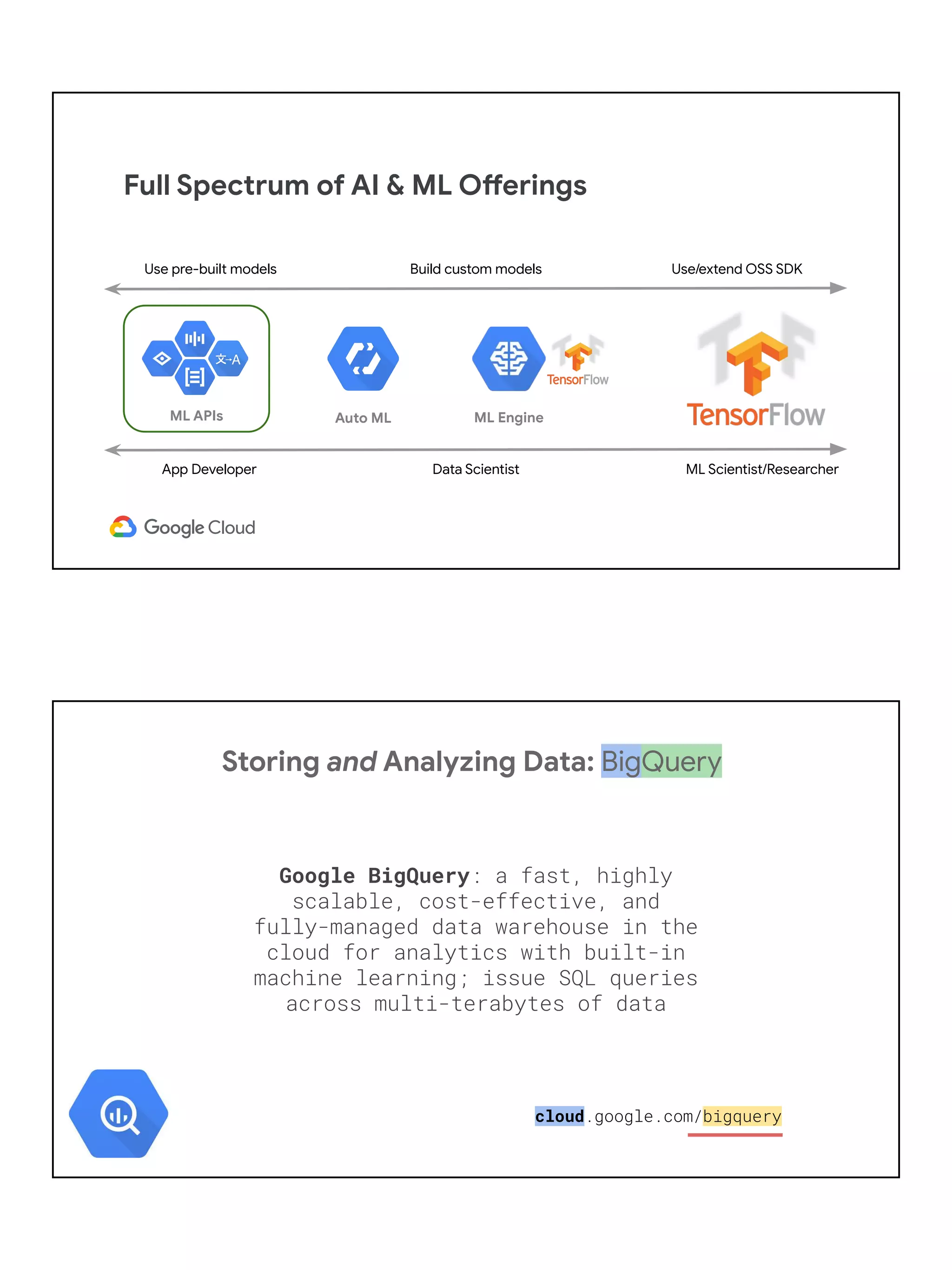
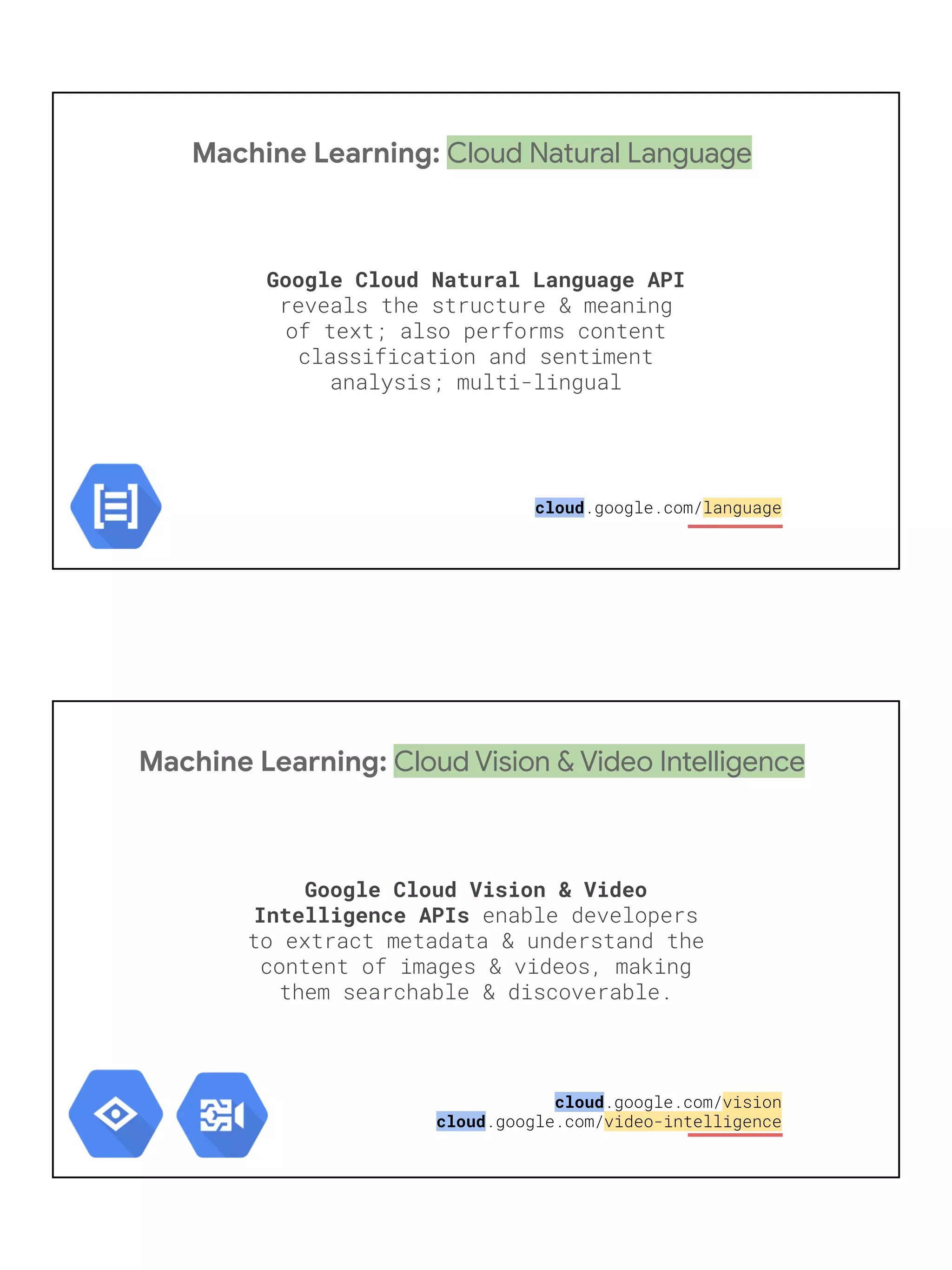
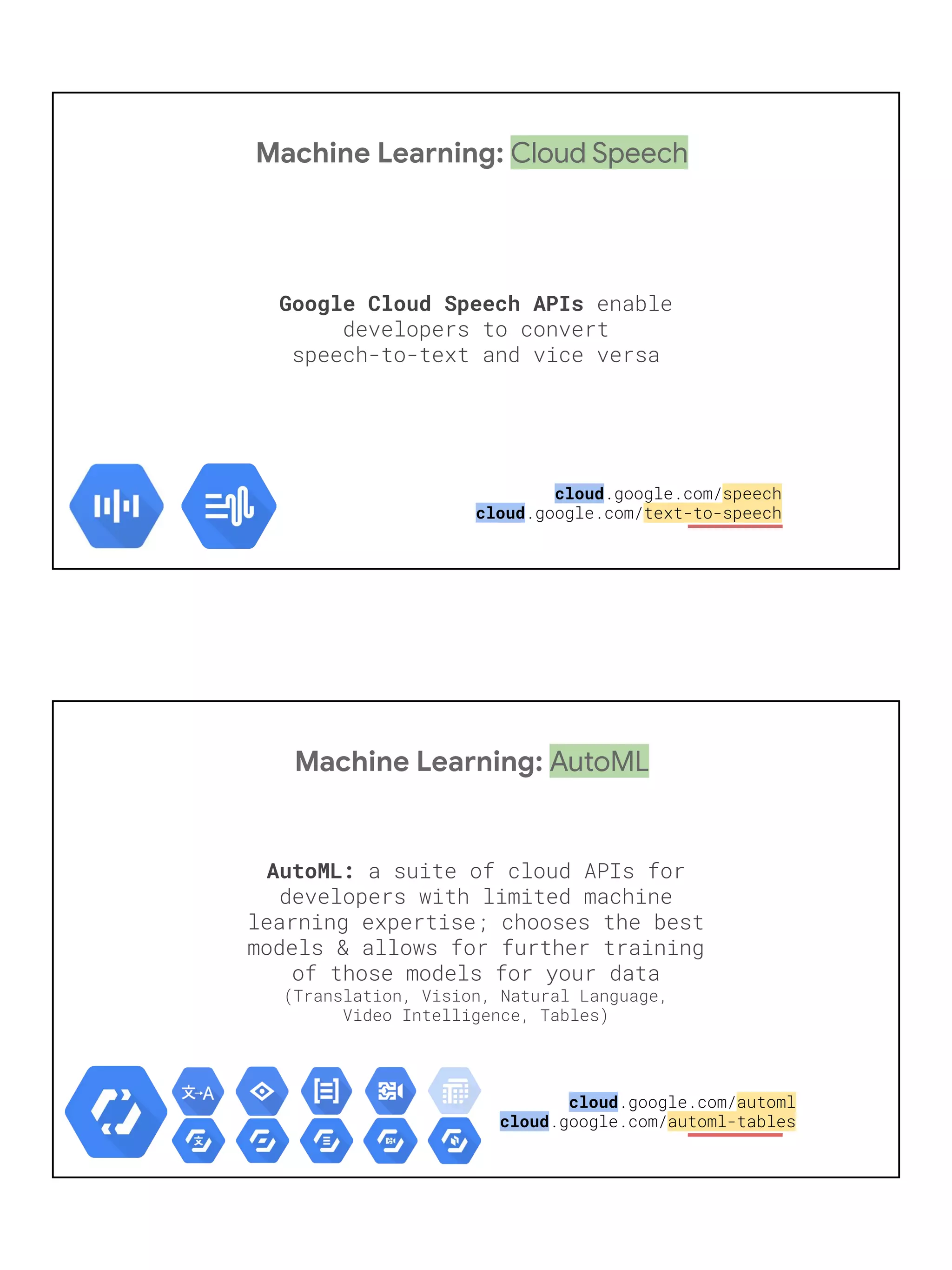


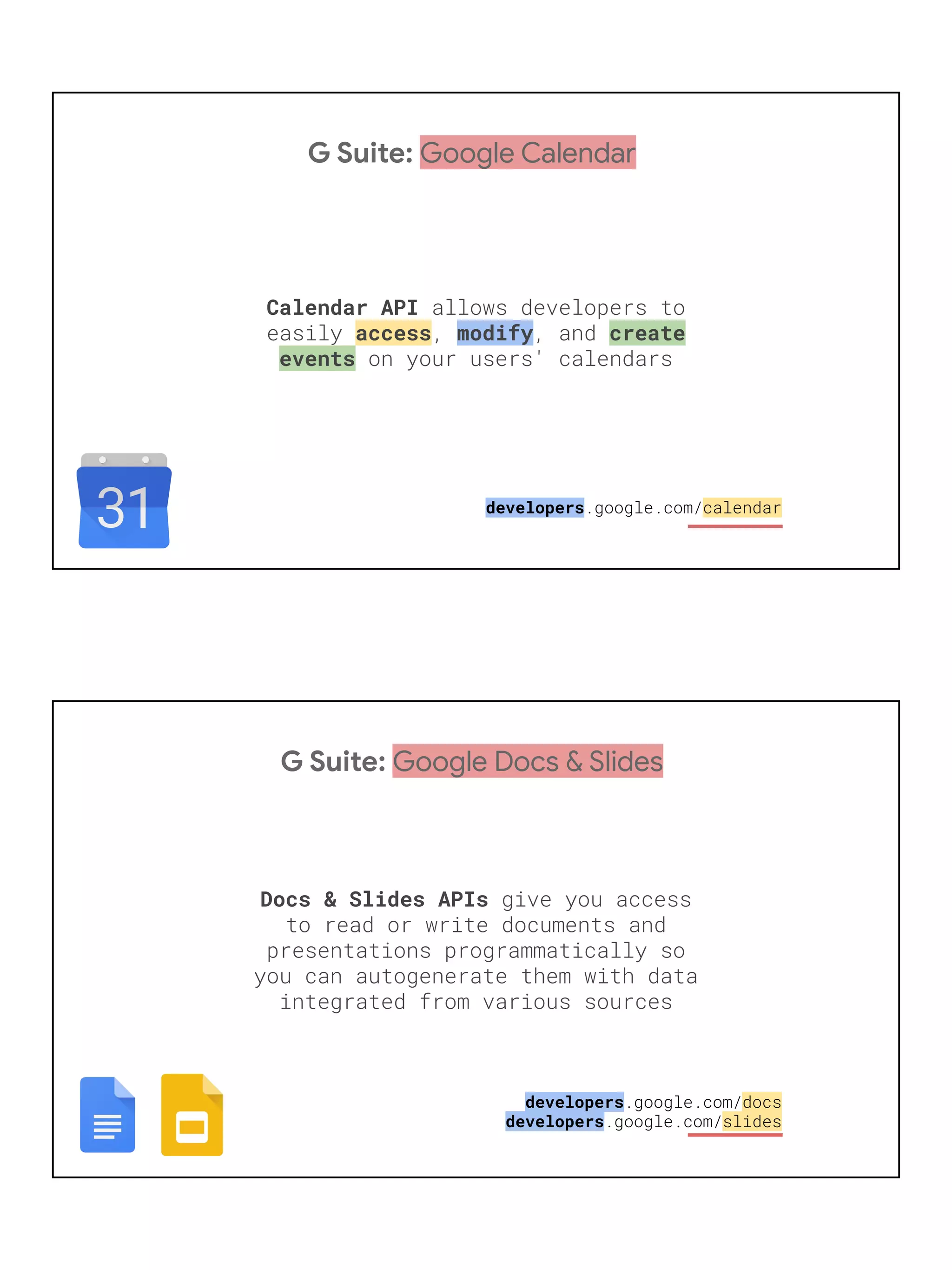
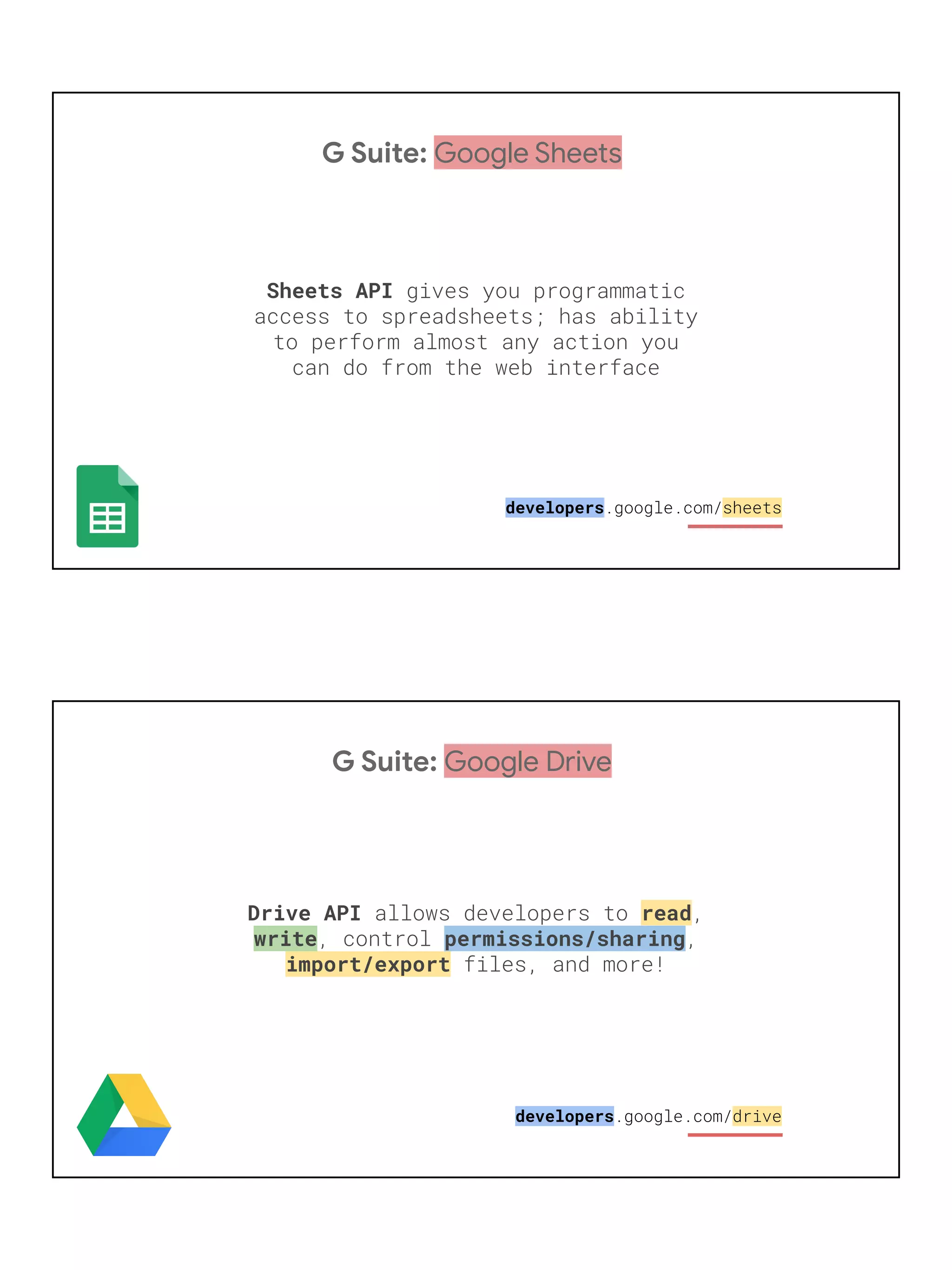




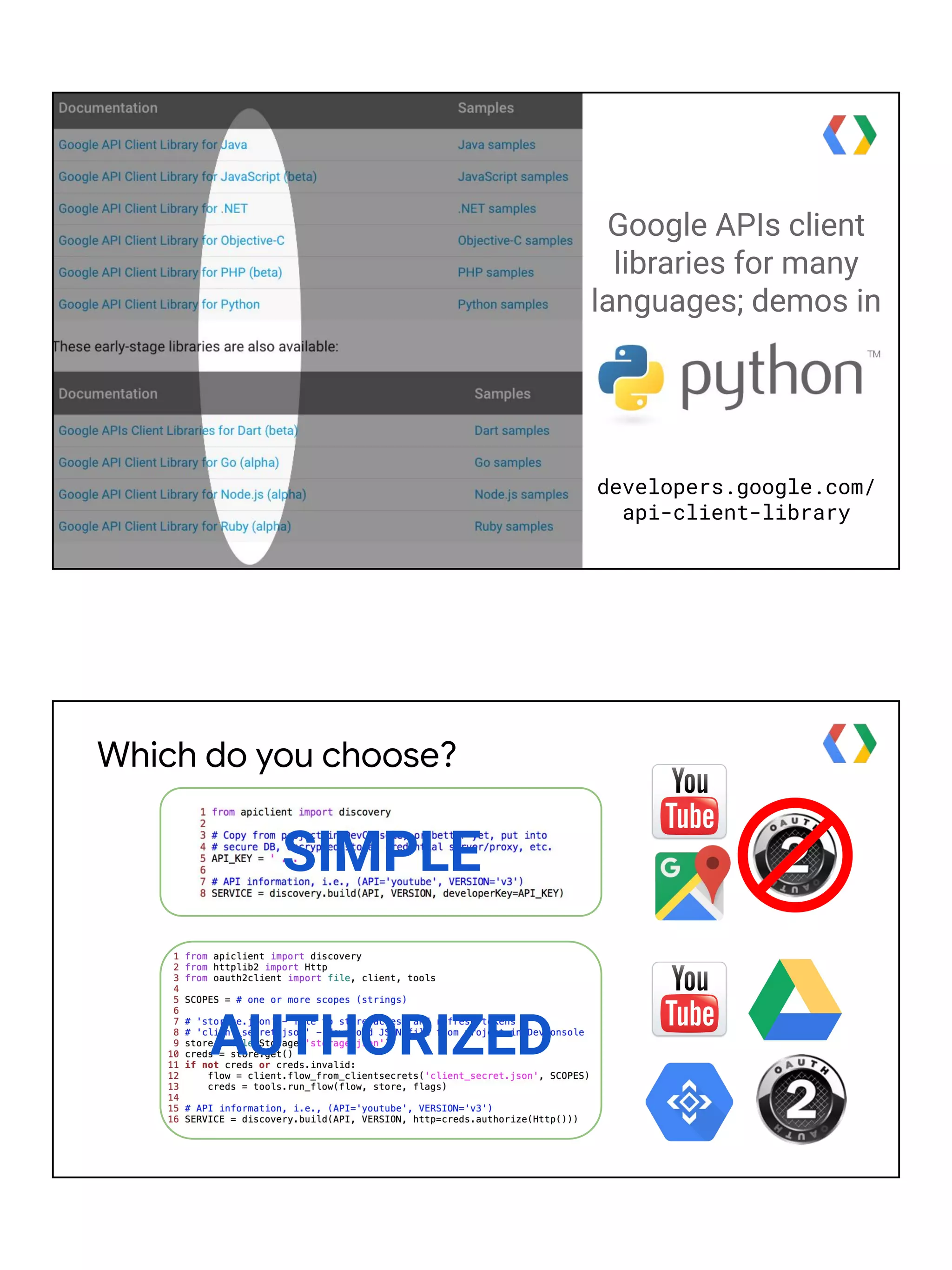
![List (first 100) files/folders in Google Drive from __future__ import print_function from googleapiclient import discovery from httplib2 import Http from oauth2client import file, client, tools SCOPES = 'https://www.googleapis.com/auth/drive.metadata.readonly' store = file.Storage('storage.json') creds = store.get() if not creds or creds.invalid: flow = client.flow_from_clientsecrets('client_secret.json', SCOPES) creds = tools.run_flow(flow, store) DRIVE = discovery.build('drive', 'v3', http=creds.authorize(Http())) files = DRIVE.files().list().execute().get('files', []) for f in files: print(f['name'], f['mimeType']) Listing your files goo.gl/ZIgf8k Try our Node.js customized reporting tool codelab: g.co/codelabs/sheets Why use the Sheets API? data visualization customized reports Sheets as a data source](https://image.slidesharecdn.com/cloud114-190930063733/75/Cloud-computing-overview-Technical-intro-to-Google-Cloud-28-2048.jpg)

![Try our Node.js Markdown-to-Google-Slides generator: github.com/gsuitedevs/md2googleslides Why use the Slides API? customized presentations Replace text & images from template deck requests = [ # (global) search-and-replace text {'replaceAllText': { 'findText': '{{TITLE}}', 'replaceText': 'Hello World!', }}, # replace text-based image placeholders (global) {'replaceAllShapesWithImage': { 'imageUrl': IMG_URL, # link to product logo 'replaceMethod': 'CENTER_INSIDE', 'containsText': {'text': '{{LOGO}}'}, }}, ] SLIDES.presentations().batchUpdate(body={'requests': requests}, presentationId=DECK_ID, fields='').execute() Replacing text and images goo.gl/o6EFwk](https://image.slidesharecdn.com/cloud114-190930063733/75/Cloud-computing-overview-Technical-intro-to-Google-Cloud-30-2048.jpg)
![+ Mail merge = Mail merge (template search & replace) requests = [ # (global) search-and-replace text {'replaceAllText': { 'containsText': {'text': '{{TITLE}}'}, 'replaceText': 'Hello World!', }}, ] DOCS.documents().batchUpdate(body={'requests': requests}, documentId=DOC_ID, fields='').execute() Mail merge goo.gle/2KrPNeG](https://image.slidesharecdn.com/cloud114-190930063733/75/Cloud-computing-overview-Technical-intro-to-Google-Cloud-31-2048.jpg)
![BigQuery: querying Shakespeare words TITLE = "The top 10 most common words in all of Shakespeare's works" QUERY = ''' SELECT LOWER(word) AS word, sum(word_count) AS count FROM [bigquery-public-data:samples.shakespeare] GROUP BY word ORDER BY count DESC LIMIT 10 ''' rsp = BQ.query(body={'query': QUERY}, projectId=PROJ_ID).execute() print('n*** Results for %r:n' % TITLE) for col in rsp['schema']['fields']: # HEADERS print(col['name'].upper(), end='t') print() for row in rsp['rows']: # DATA for col in row['f']: print(col['v'], end='t') print() Top 10 most common Shakespeare words $ python bq_shake.py *** Results for "The most common words in all of Shakespeare's works": WORD COUNT the 29801 and 27529 i 21029 to 20957 of 18514 a 15370 you 14010 my 12936 in 11722 that 11519](https://image.slidesharecdn.com/cloud114-190930063733/75/Cloud-computing-overview-Technical-intro-to-Google-Cloud-32-2048.jpg)
![Simple sentiment & classification analysis TEXT = '''Google, headquartered in Mountain View, unveiled the new Android phone at the Consumer Electronics Show. Sundar Pichai said in his keynote that users love their new Android phones.''' print('TEXT:', TEXT) data = {'type': 'PLAIN_TEXT', 'content': TEXT} NL = discovery.build('language', 'v1', developerKey=API_KEY) # sentiment analysis sent = NL.documents().analyzeSentiment( body={'document': data}).execute().get('documentSentiment') print('nSENTIMENT: score (%s), magnitude (%s)' % (sent['score'], sent['magnitude'])) # content classification print('nCATEGORIES:') cats = NL.documents().classifyText(body={'document': data}).execute().get('categories') for cat in cats: print('* %s (%s)' % (cat['name'][1:], cat['confidence'])) Simple sentiment & classification analysis $ python nl_sent_simple.py TEXT: Google, headquartered in Mountain View, unveiled the new Android phone at the Consumer Electronics Show. Sundar Pichai said in his keynote that users love their new Android phones. SENTIMENT: score (0.3), magnitude (0.6) CATEGORIES: * Internet & Telecom (0.76) * Computers & Electronics (0.64) * News (0.56)](https://image.slidesharecdn.com/cloud114-190930063733/75/Cloud-computing-overview-Technical-intro-to-Google-Cloud-33-2048.jpg)
![Text-to-Speech: synthsizing audio text # request body (with text body using 16-bit linear PCM audio encoding) body = { 'input': {'text': text}, 'voice': { 'languageCode': 'en-US', 'ssmlGender': 'FEMALE', }, 'audioConfig': {'audioEncoding': 'LINEAR16'}, } # call Text-to-Speech API to synthesize text (write to text.wav file) T2S = discovery.build('texttospeech', 'v1', developerKey=API_KEY) audio = T2S.text().synthesize(body=body).execute().get('audioContent') with open('text.wav', 'wb') as f: f.write(base64.b64decode(audio)) Speech-to-Text: transcribing audio text # request body (16-bit linear PCM audio content, i.e., from text.wav) body = { 'audio': {'content': audio}, 'config': { 'languageCode': 'en-US', 'encoding': 'LINEAR16', }, } # call Speech-to-Text API to recognize text S2T = discovery.build('speech', 'v1', developerKey=API_KEY) rsp = S2T.speech().recognize( body=body).execute().get('results')[0]['alternatives'][0] print('** %.2f%% confident of this transcript:n%r' % ( rsp['confidence']*100., rsp['transcript']))](https://image.slidesharecdn.com/cloud114-190930063733/75/Cloud-computing-overview-Technical-intro-to-Google-Cloud-34-2048.jpg)
![Speech-to-Text: transcribing audio text $ python s2t_demo.py ** 92.03% confident of this transcript: 'Google headquarters in Mountain View unveiled the new Android phone at the Consumer Electronics Show Sundar pichai said in his keynote that users love their new Android phones' Video intelligence: make videos searchable # request body (single payload, base64 binary video) body = { "inputContent": video, "features": ['LABEL_DETECTION', 'SPEECH_TRANSCRIPTION'], "videoContext": {"speechTranscriptionConfig": {"languageCode": 'en-US'}}, } # perform video shot analysis followed by speech analysis VINTEL = discovery.build('videointelligence', 'v1', developerKey=API_KEY) resource = VINTEL.videos().annotate(body=body).execute().get('name') while True: results = VINTEL.operations().get(name=resource).execute() if results.get('done'): break time.sleep(random.randrange(8)) # expo-backoff probably better](https://image.slidesharecdn.com/cloud114-190930063733/75/Cloud-computing-overview-Technical-intro-to-Google-Cloud-35-2048.jpg)
![Video intelligence: make videos searchable # display shot labels followed by speech transcription for labels in results['response']['annotationResults']: if 'shotLabelAnnotations' in labels: print('n** Video shot analysis labeling') for shot in labels['shotLabelAnnotations']: seg = shot['segments'][0] print(' - %s (%.2f%%)' % ( shot['entity']['description'], seg['confidence']*100.)) if 'speechTranscriptions' in labels: print('** Speech transcription') speech = labels['speechTranscriptions'][0]['alternatives'][0] print(' - %r (%.2f%%)' % ( speech['transcript'], speech['confidence']*100.)) Video intelligence: make videos searchable $ python3 vid_demo.py you-need-a-hug.mp4 ** Video shot analysis labeling - vacation (30.62%) - fun (61.53%) - interaction (38.93%) - summer (57.10%) ** Speech transcription - 'you need a hug come here' (79.27%)](https://image.slidesharecdn.com/cloud114-190930063733/75/Cloud-computing-overview-Technical-intro-to-Google-Cloud-36-2048.jpg)






![Accessing maps from spreadsheets?!? goo.gl/oAzBN9 This… with help from Google Maps & Gmail function sendMap() { var sheet = SpreadsheetApp.getActiveSheet(); var address = sheet.getRange("A2").getValue(); var map = Maps.newStaticMap().addMarker(address); GmailApp.sendEmail('friend@example.com', 'Map', 'See below.', {attachments:[map]}); } JS Google Cloud Run Container-hosting in the cloud](https://image.slidesharecdn.com/cloud114-190930063733/75/Cloud-computing-overview-Technical-intro-to-Google-Cloud-43-2048.jpg)
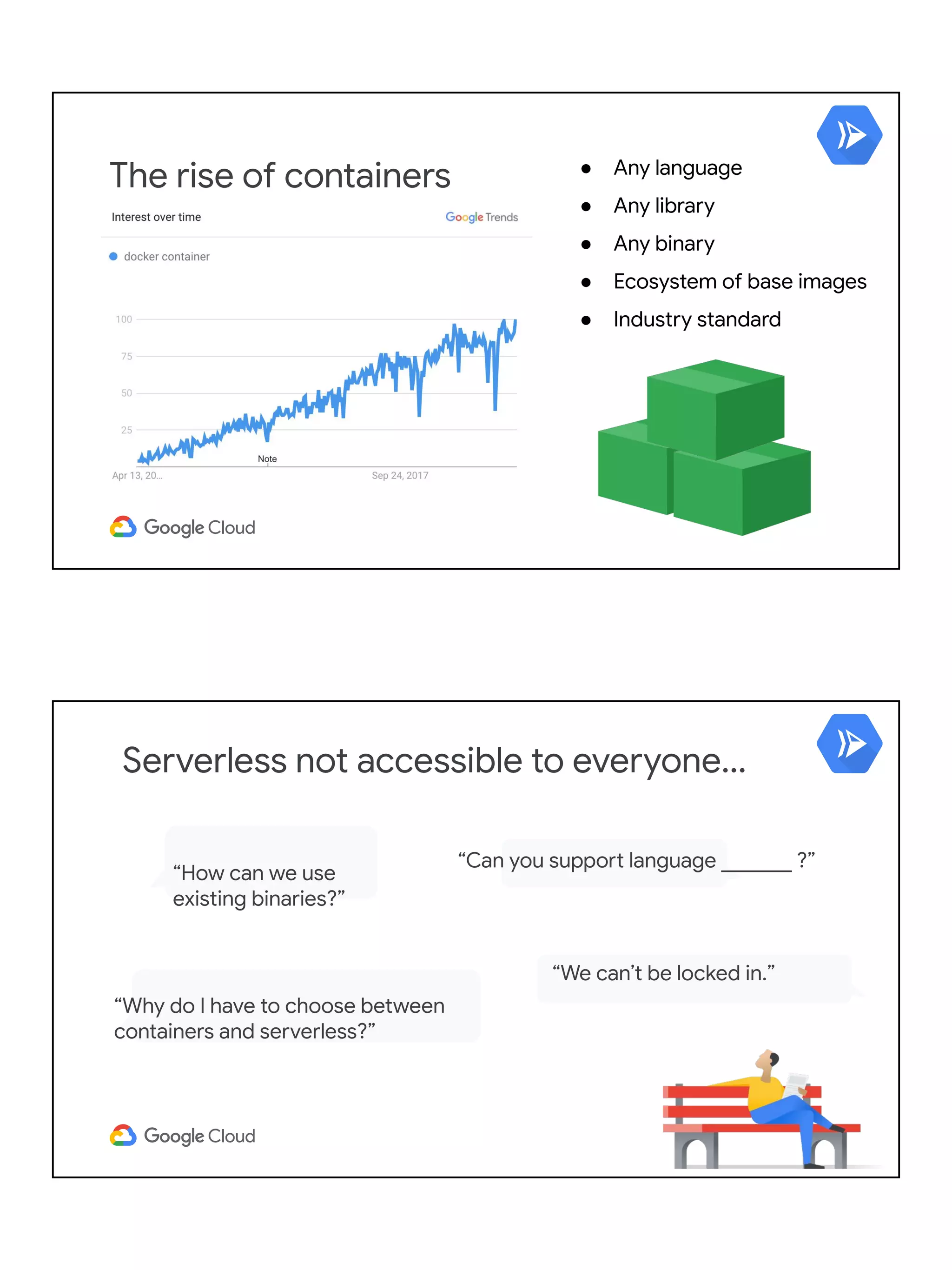

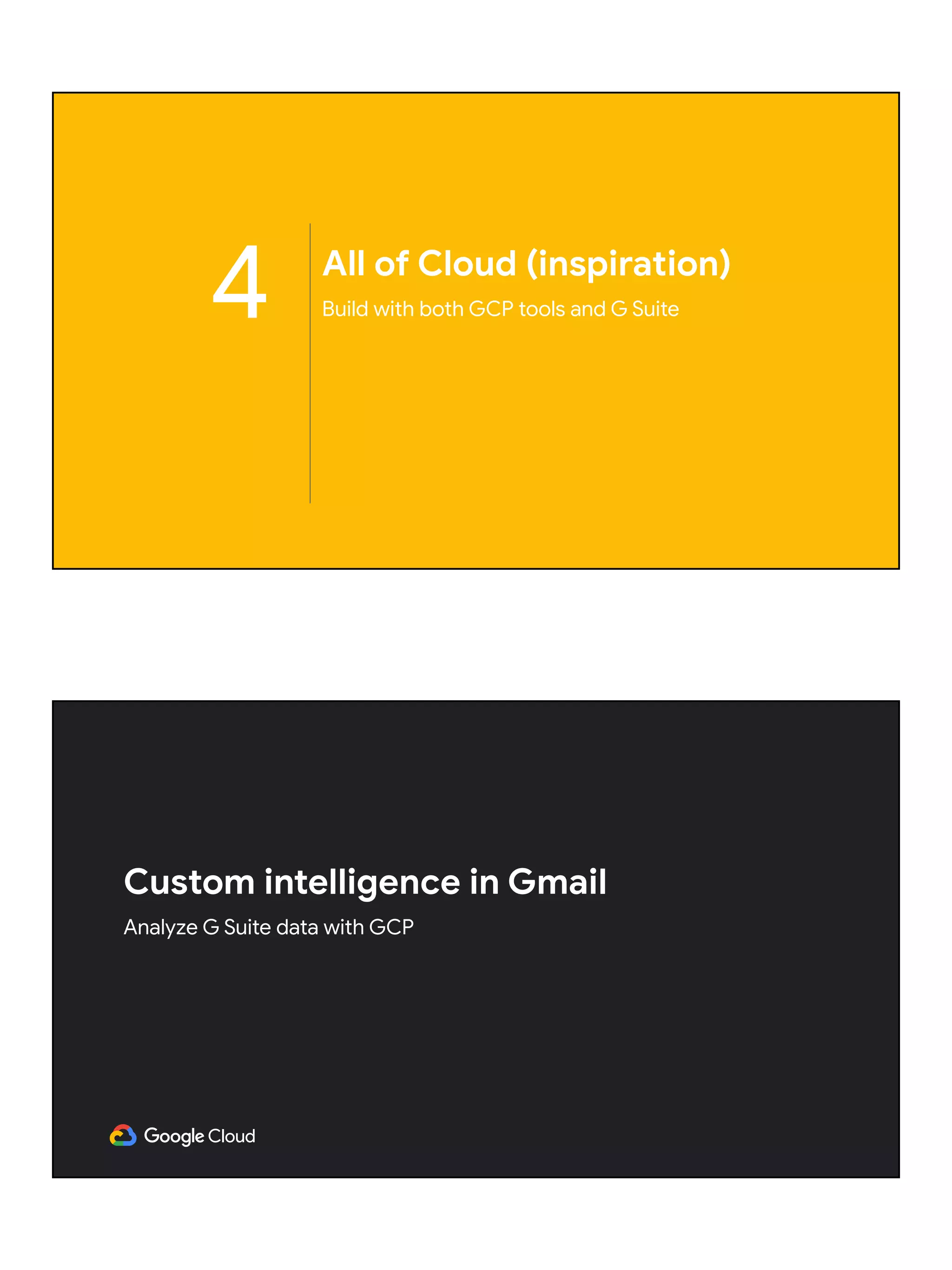
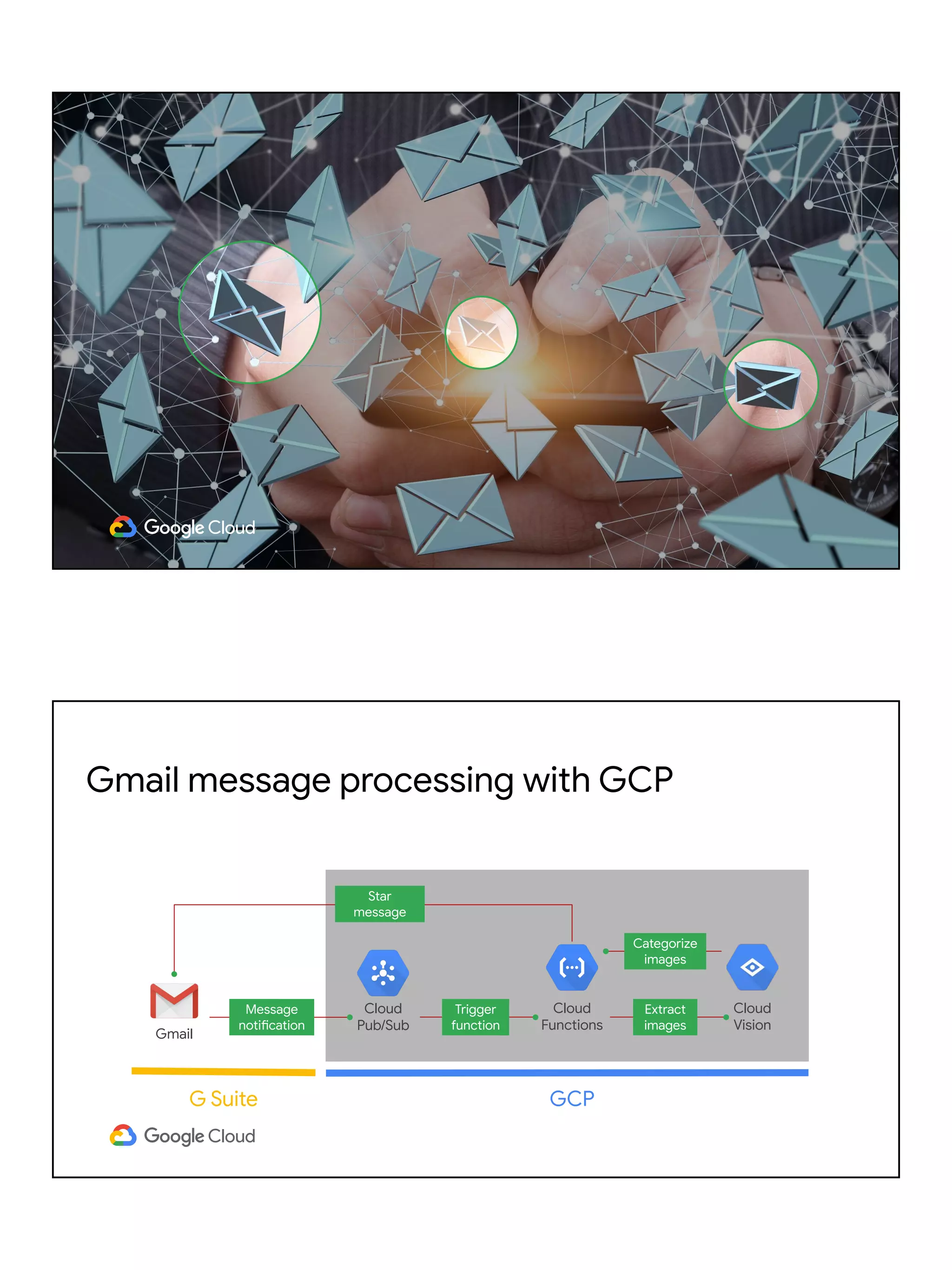
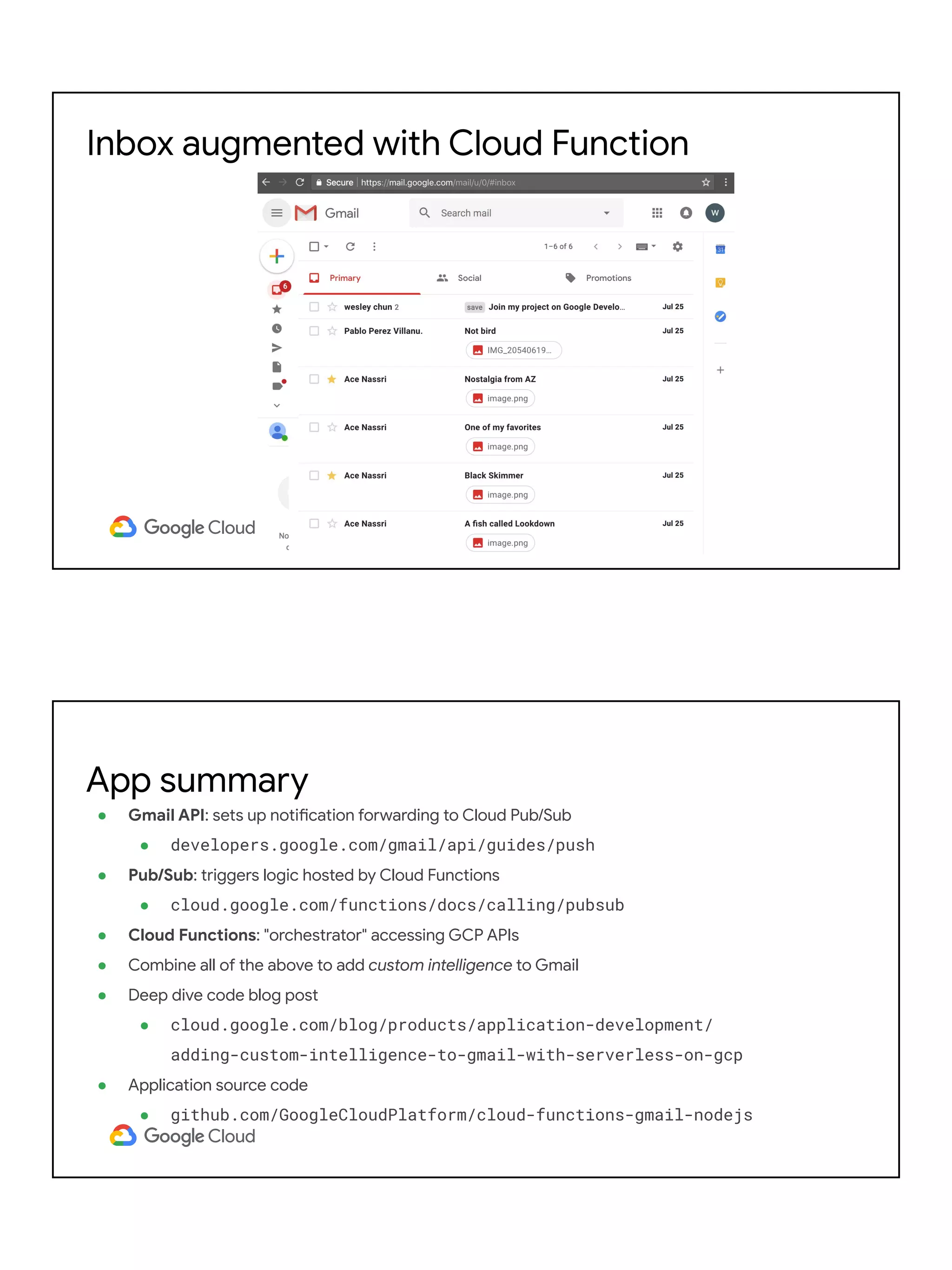
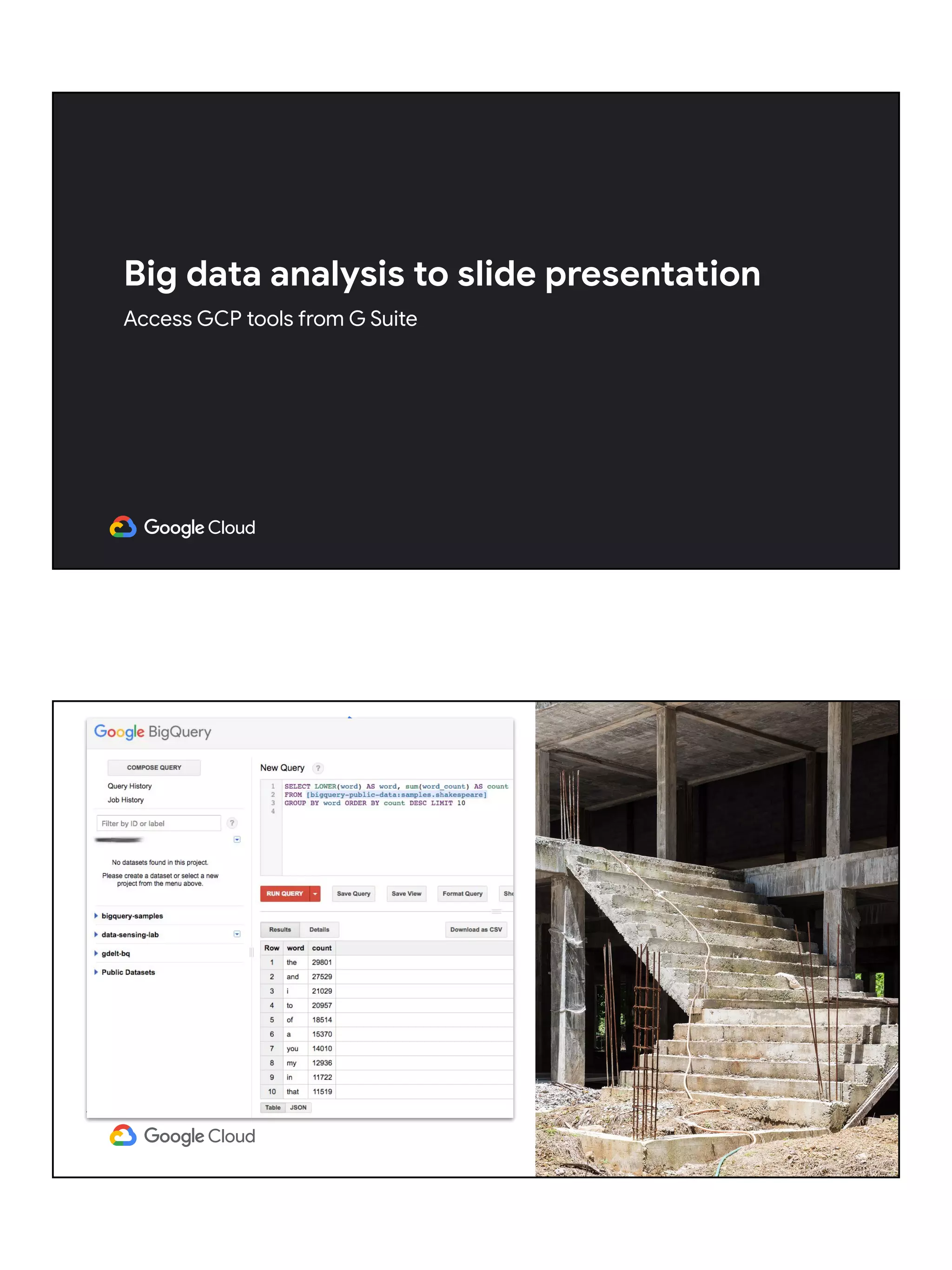

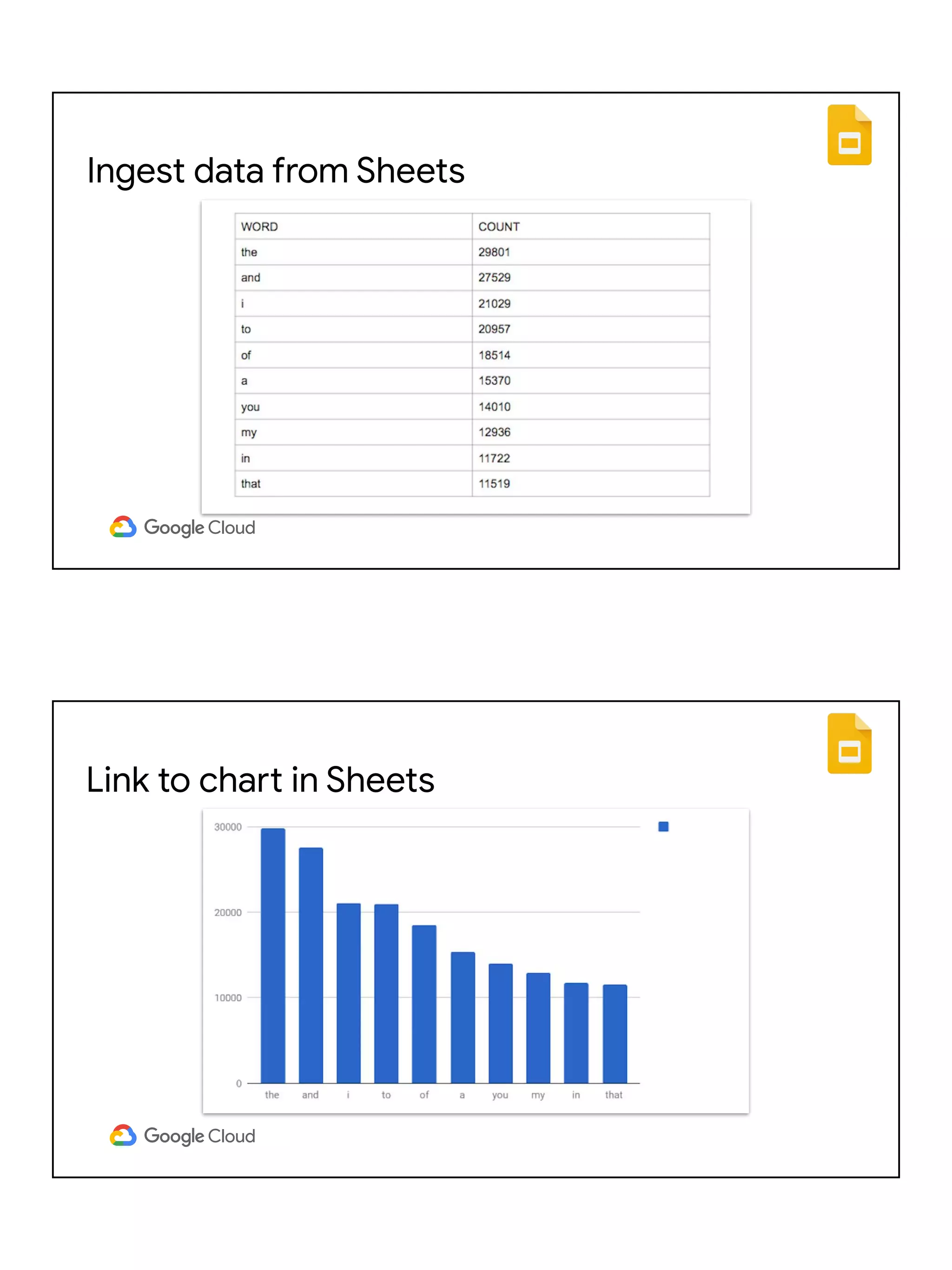
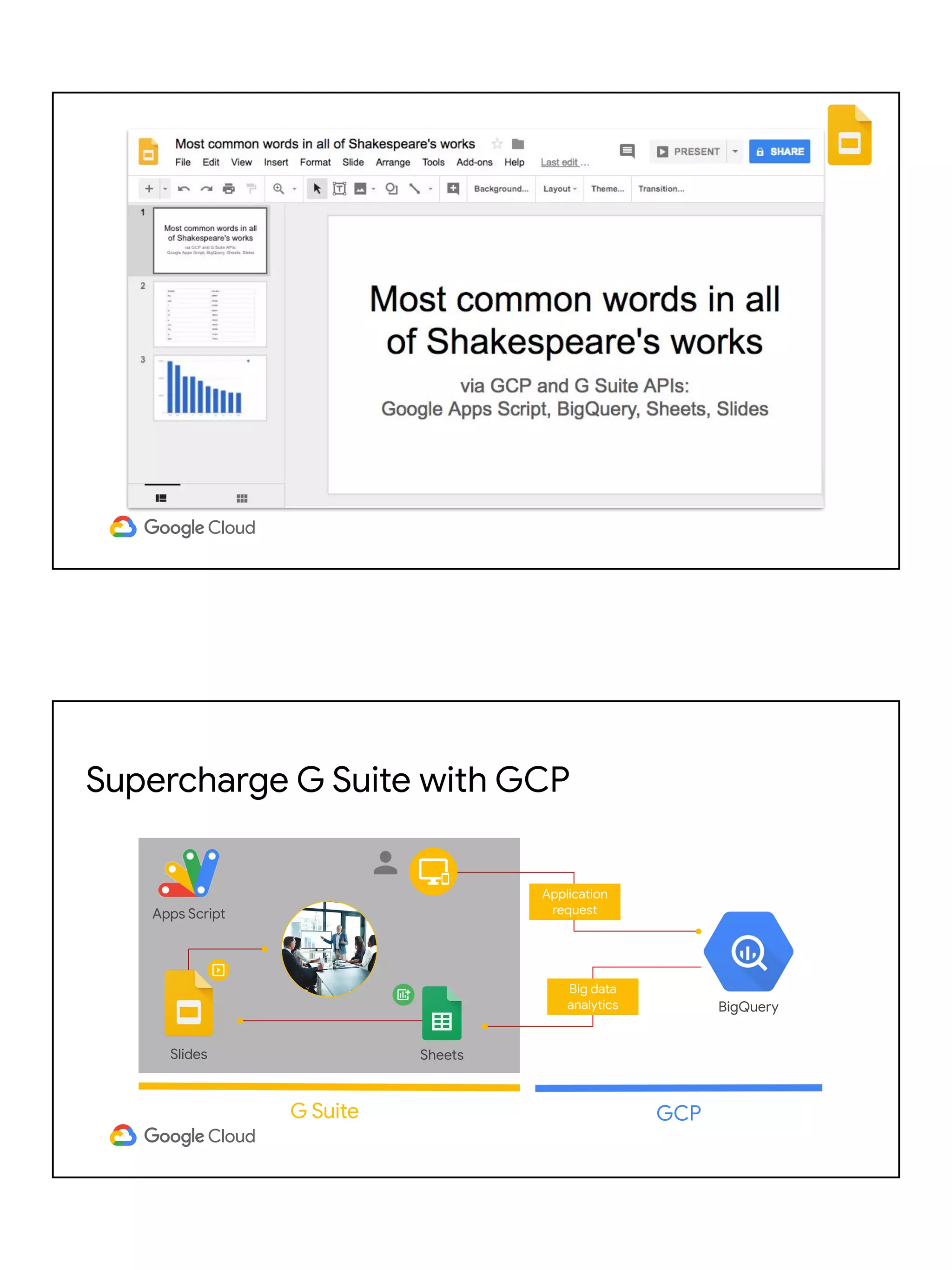
![App summary ● Leverage GCP and build the "final mile" with G Suite ● Driven by Google Apps Script ● Google BigQuery for data analysis ● Google Sheets for visualization ● Google Slides for presentable results ● "Glued" together w/G Suite serverless ● Build this app (codelab) ● g.co/codelabs/bigquery-sheets-slides ● Video and blog post ● bit.ly/2OcptaG ● Application source code ● github.com/googlecodelabs/bigquery-sheets-slides ● Presented at Google Cloud NEXT (Jul 2018 [DEV229] & Apr 2019 [DEV212]) ● cloud.withgoogle.com/next18/sf/sessions/session/156878 ● cloud.withgoogle.com/next/sf/sessions?session=DEV212 Online resources & summary What's available for students & educators?5](https://image.slidesharecdn.com/cloud114-190930063733/75/Cloud-computing-overview-Technical-intro-to-Google-Cloud-53-2048.jpg)

![More references ● Relevant videos ○ goo.gl/RbyTFD (new Google APIs project setup) ○ goo.gl/KMfbeK (common Python OAuth2 boilerplate code review) ○ goo.gl/ZIgf8k (APIs intro codelab [Drive API]) ● Relevant codelabs ○ g.co/codelabs/gsuite-apis-intro (Drive API) ○ g.co/codelabs/apps-script-intro ○ codelabs.developers.google.com/codelabs/cloud-app-engine-python ○ codelabs.developers.google.com/codelabs/cloud-starting-cloudfunctions ● Inspirational apps ○ bit.ly/2OcptaG ○ cloud.google.com/blog/products/application-development/ adding-custom-intelligence-to-gmail-with-serverless-on-gcp ○ cloud.withgoogle.com/next/sf/sessions?session=DEV212 Learning resources ● Codelabs: self-paced, hands-on tutorials ○ Google codelabs: need a Gmail account, always free ■ g.co/codelabs/cloud ○ Qwiklabs codelabs: don't need a Gmail acct; typically not free ■ google.qwiklabs.com ■ Puchase credits a la carte, or discounted in-bulk / via subscription ● Official GCP documentation ○ cloud.google.com/gcp/getting-started ○ Recommended: Getting Started, Cloud Console, Cloud Shell, Cloud SDK, Community ● YouTube video series: ○ youtube.com/GoogleCloud ○ Recommended: Cloud Minute shorts & Cloud NEXT videos ○ G Suite Dev Show: goo.gl/JpBQ40](https://image.slidesharecdn.com/cloud114-190930063733/75/Cloud-computing-overview-Technical-intro-to-Google-Cloud-55-2048.jpg)
